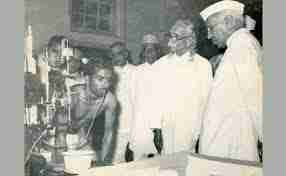
Swami Kuvalayananda, a respected figure in the world of yoga, was born on 30 August 1883, as Jagannatha Ganesa Gune in a traditional Karhade Brahmin family. His birthplace is the village of Dabhoi, located near Vadodara (Baroda) in the state of Gujarat, India.
Being from a poor family, Kuvalayananda faced significant challenges in his pursuit of education. However, his determination and perseverance enabled him to overcome these obstacles. In recognition of his academic potential, he was honored with the prestigious Jagannath Shankarsheth Sanskrit Scholarship upon completing his matriculation in 1903. This scholarship provided him with the opportunity to study at Baroda College, where he successfully graduated in 1910. Kuvalayananda’s educational achievements serve as a testament to his dedication and hard work in the face of adversity. He had a rational approach to yoga.
Jummadado Vyāyamśāla, a gymnasium in Vadodara
Swami Kuvalayananda, was first introduced to the practices of postural yoga at the Jummadado Vyāyamśāla, a gymnasium in Baroda. It was within this setting that he was initially exposed to the techniques and principles of yoga asanas.
Swami Kuvalayananda’s significant contribution dispelling myths and misconceptions about yoga.
Before the time of Swami Kuvalayananda, the knowledge of yoga remained largely confined to the ancient sages and Rishi Munis. However, the benefits and practices of yoga were not widely known among the common people. There existed a misconception that yoga was a complex discipline reserved exclusively for the enlightened Rishi Munis, with no practical benefits for the general population. Swami Kuvalayananda’s significant contribution was in dispelling these myths and misconceptions, as he sought to make yoga accessible and beneficial to all. His efforts played a pivotal role in popularizing yoga and educating people about its numerous advantages, ultimately paving the way for its widespread adoption and recognition as a transformative practice for individuals from all walks of life.
5 Reasons for a rational mind to accept yoga – Read more
Yoga became a profound mission for Swami Kuvalayananda, encompassing a comprehensive message for humanity. In his own words from 1964, he expressed that yoga carries a holistic message for the entirety of human existence. Firstly, it holds a message for the human body, guiding individuals towards physical well-being, strength, and vitality. Secondly, it offers a message for the human mind, facilitating mental clarity, peace, and emotional balance. Lastly, it conveys a message for the human soul, providing a pathway for spiritual growth, self-realization, and connection to the divine.
"In our Indian effort to scientifically investigate the field of Yoga, science is looking not only at the heart of the human being but also at its mind and spirit and is trying to develop a perfectly integrated personality, not only for an individual but for the whole of mankind"
- Swami Kuvalayananda Founder Kaivalyadhama
Swami Kuvalyananda’s conducted the first-ever experiment on yoga at the (Vadodara) Baroda State Hospital.
In the 1920s, Swami Kuvalyananda adopted a scientific approach to explore the physiological benefits of yoga on the nervous and endocrine systems. Embracing the trappings of modern science, he even adorned a lab coat while conducting experiments. Swami Kuvalyananda’s pioneering efforts led him to conduct the first-ever experiment on yoga at the Baroda State Hospital.
This significant endeavor left an enduring impact on the global landscape of yoga. During this period, the scientific exploration of yoga aligned with a broader cultural and nationalist movement in India, aiming to showcase a modern and progressive India to the world. Swami Kuvalyananda’s scientific approach to yoga was a part of this larger movement, which sought to unveil the richness and relevance of Indian traditions in the context of a changing world.
Swami Kuvalayanandaa published the first ever scientific journal of yoga Mimamsa
Swami Kuvalayananda made a groundbreaking contribution to the field of yoga by publishing the world’s first scientific journal dedicated to the subject. This significant achievement marked a pivotal moment in the history of yoga. With a vision to make the benefits of yoga accessible to all, Swami Kuvalayananda took a significant step in 1924 by founding and publishing “YOGA MIMANSHA.” The journal served as a valuable resource, fostering a deeper understanding of yoga’s physiological, psychological, and spiritual dimensions. Swami Kuvalayananda’s pioneering efforts in establishing the first scientific journal of yoga not only advanced the field but also paved the way for further scientific inquiry, contributing to the widespread recognition and acceptance of yoga as a credible discipline.
Swami Kuvalayananda wrote some books including the book “Asana” written in 1933. These books were quite rich in content and figures. The book “Asanas” by Swami Kuvalayananda has proven to be highly beneficial for students, regardless of gender. In fact, an overwhelming majority of participants (87.68%) in a study expressed their strong agreement (70.76%) or normal agreement (16.92%) in recommending the book as a textbook for undergraduate physical education classes. This indicates the wide acceptance and positive reception of “Asanas” among students. Swami Kuvalayananda’s book has evidently provided valuable insights and guidance on the practice of asanas, making it a valuable resource for both male and female students pursuing physical education. Its inclusion as a textbook further demonstrates the recognition of its educational and instructional value in enhancing students’ understanding and practice of asanas.





